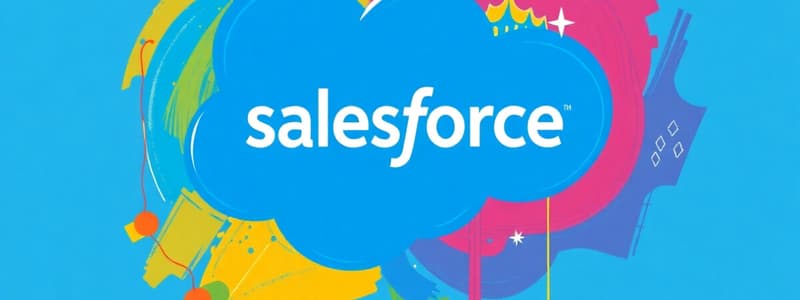Podcast
Questions and Answers
What is the primary purpose of User Management in Salesforce?
What is the primary purpose of User Management in Salesforce?
- To automate marketing campaigns.
- To set up users and control how they can view or edit business data. (correct)
- To customize the look and feel of the Salesforce interface.
- To integrate Salesforce with external accounting systems.
When sharing a file in Salesforce, what aspect is primarily addressed by understanding the file's sharing settings?
When sharing a file in Salesforce, what aspect is primarily addressed by understanding the file's sharing settings?
- The file's storage size limits.
- The file's compatibility with different devices.
- Who has access to view or modify the file. (correct)
- The file's backup and recovery options.
In the context of legacy reports and dashboards, what is the main reason for using legacy folder sharing in Salesforce Classic?
In the context of legacy reports and dashboards, what is the main reason for using legacy folder sharing in Salesforce Classic?
- To enhance the visual appeal of reports and dashboards.
- To avoid needing to reassign permissions. (correct)
- To enable mobile access to reports and dashboards.
- To improve the loading speed of reports and dashboards.
What does controlling access to records in Salesforce primarily involve?
What does controlling access to records in Salesforce primarily involve?
What is the key benefit of using Custom Permissions in Salesforce?
What is the key benefit of using Custom Permissions in Salesforce?
What does Built-in Sharing Behavior in Salesforce primarily ensure?
What does Built-in Sharing Behavior in Salesforce primarily ensure?
What is the defining characteristic of Implicit Sharing in Salesforce concerning object relationships?
What is the defining characteristic of Implicit Sharing in Salesforce concerning object relationships?
What is the primary distinction between Customer Community, Customer Community Plus, and Partner Community licenses in Salesforce?
What is the primary distinction between Customer Community, Customer Community Plus, and Partner Community licenses in Salesforce?
What is the main function of Share Groups in Salesforce?
What is the main function of Share Groups in Salesforce?
What is a key aspect introduced by Enterprise Territory Management that builds upon its original features?
What is a key aspect introduced by Enterprise Territory Management that builds upon its original features?
What does programmatic sharing in Apex enable you to do?
What does programmatic sharing in Apex enable you to do?
What issue does avoiding Account Data Skew primarily address?
What issue does avoiding Account Data Skew primarily address?
Why should the Salesforce Group Architecture be leveraged?
Why should the Salesforce Group Architecture be leveraged?
Why is it important to implement coding strategies to protect custom sharing code?
Why is it important to implement coding strategies to protect custom sharing code?
What is the main objective of enforcing sharing rules in Apex?
What is the main objective of enforcing sharing rules in Apex?
What is a key consideration when addressing complex sales realignment?
What is a key consideration when addressing complex sales realignment?
What is the primary goal of implementing Platform Encryption in Salesforce?
What is the primary goal of implementing Platform Encryption in Salesforce?
For Salesforce Communities, what is the significance of understanding the sharing settings for files?
For Salesforce Communities, what is the significance of understanding the sharing settings for files?
Why is it important to consider Account Data Skew when implementing sharing rules?
Why is it important to consider Account Data Skew when implementing sharing rules?
What role do Custom Permissions play in managing access to custom applications?
What role do Custom Permissions play in managing access to custom applications?
What is the primary benefit of using managed sharing in Apex?
What is the primary benefit of using managed sharing in Apex?
When should legacy folder sharing be preferred over enhanced folder sharing?
When should legacy folder sharing be preferred over enhanced folder sharing?
Besides Apex, what other Salesforce feature can be used to control access to records?
Besides Apex, what other Salesforce feature can be used to control access to records?
How does Built-in Sharing Behavior relate accounts to child records?
How does Built-in Sharing Behavior relate accounts to child records?
In the context of Salesforce Communities, where are share groups useful?
In the context of Salesforce Communities, where are share groups useful?
What does Enterprise Territory Management enable you to create?
What does Enterprise Territory Management enable you to create?
When using Apex to access programmatic sharing, what types of sharing can you create?
When using Apex to access programmatic sharing, what types of sharing can you create?
What situation does avoiding Account Data Skew avoid?
What situation does avoiding Account Data Skew avoid?
Instead of improving the performance applications, what is another use case for the Salesforce Group Architecture?
Instead of improving the performance applications, what is another use case for the Salesforce Group Architecture?
When wanting to utilize Salesforce's sharing functionality, how are custom sharing rules handled?
When wanting to utilize Salesforce's sharing functionality, how are custom sharing rules handled?
When ensuring sensitive data is not exposed, what is a solution to implement?
When ensuring sensitive data is not exposed, what is a solution to implement?
When addressing a complex sales realignment strategy, what is an area of focus?
When addressing a complex sales realignment strategy, what is an area of focus?
When proving company compliance with privacy policies, what solution is implemented?
When proving company compliance with privacy policies, what solution is implemented?
What is the correct order of steps to implement enterprise territory management?
What is the correct order of steps to implement enterprise territory management?
When deciding on the appropriate Community User License, what would be the primary factor?
When deciding on the appropriate Community User License, what would be the primary factor?
What implications should be considered when dealing with data skew?
What implications should be considered when dealing with data skew?
What benefit comes from leveraging the Salesforce Group Architecture?
What benefit comes from leveraging the Salesforce Group Architecture?
What consideration must be made for custom sharing code?
What consideration must be made for custom sharing code?
Data exposure can occur if what functionality isn't properly enforced?
Data exposure can occur if what functionality isn't properly enforced?
Technical and process issues are associated with addressing what challenge?
Technical and process issues are associated with addressing what challenge?
Why should companies implement Platform Encryption?
Why should companies implement Platform Encryption?
Flashcards
User Management
User Management
Controls how users can view or edit business data.
File Sharing Settings
File Sharing Settings
Sharing settings determine who can see a file.
Manual Record Sharing
Manual Record Sharing
Manually granting access to records like accounts, contacts, and leads.
Custom Permissions
Custom Permissions
Signup and view all the flashcards
Implicit Sharing
Implicit Sharing
Signup and view all the flashcards
Share Groups
Share Groups
Signup and view all the flashcards
Apex Sharing
Apex Sharing
Signup and view all the flashcards
Enterprise Territory Management
Enterprise Territory Management
Signup and view all the flashcards
Account Data Skew
Account Data Skew
Signup and view all the flashcards
Group Membership Sharing
Group Membership Sharing
Signup and view all the flashcards
Protecting Custom Sharing Code
Protecting Custom Sharing Code
Signup and view all the flashcards
Enforcing Sharing Rules
Enforcing Sharing Rules
Signup and view all the flashcards
Platform Encryption
Platform Encryption
Signup and view all the flashcards
Study Notes
- Users can be set up and access to business data can be controlled.
File Sharing Settings
- Sharing settings for a file can be identified and changed.
Legacy Folder Sharing
- Legacy folder sharing in Salesforce Classic avoids reassigning permissions for legacy reports and dashboards.
Record Access
- Users can manually grant other users access to specific records like accounts, contacts, and leads.
Custom Permissions
- Custom permissions grant users access to custom processes or apps.
Built-In Sharing Behavior
- Salesforce provides implicit sharing between accounts and child records and for various groups of portal users.
Implicit Sharing Types
- Different types of implicit sharing exist, each providing a specific type of record access.
Community User Licenses
- There are differences between external user Community licenses.
- Customer Community, Customer Community Plus, and Partner Community licenses are all such licenses.
Share Groups
- Share Groups allow sharing of records owned by high-volume community users.
Enterprise Territory Management
- Enterprise Territory Management introduces territory types, models, and model states, building upon original features.
Apex Sharing
- Programmatic sharing can be accessed using Apex to create User Managed Sharing and Managed Sharing.
Account Data Skew
- Account Data Skew causes unwanted lock contention and reduced database concurrency when managing Salesforce solutions.
Group Membership Sharing
- The Salesforce Group Architecture can be used as a performance tool to improve application performance.
Custom Sharing Code
- Advanced sharing features and coding strategies can prevent Force.com from interfering with sharing code.
Sharing Rules
- Sharing rules may not be enforced when using Apex, which can expose sensitive data.
Sales Realignment
- Best practices for technical and process issues around complex sales realignment are available from the Salesforce Technical Enablement team.
Platform Encryption
- Platform Encryption helps organizations comply with privacy policies, regulatory requirements, and contractual obligations for handling private data.
Studying That Suits You
Use AI to generate personalized quizzes and flashcards to suit your learning preferences.




